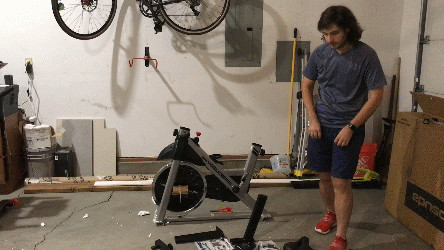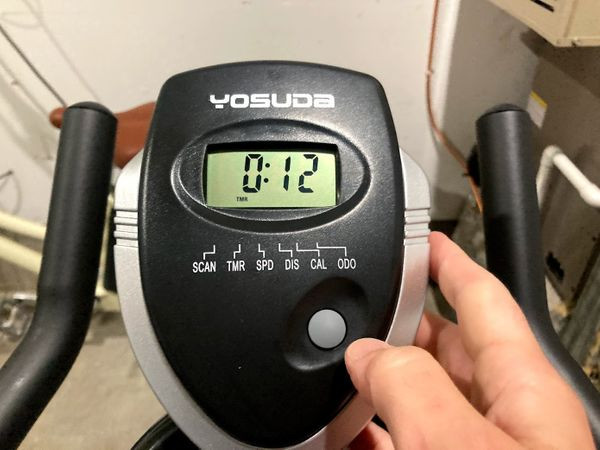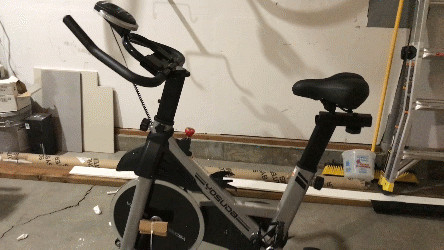Building a home gym doesn’t have to break the bank. Last year, I embarked on a journey to create my own workout space, starting with a DIY spin bike setup for around $400. After nine months and over 150 rides on my Sunny SF-B1002 bike combined with a moofit cadence sensor, I’m still impressed with their performance and durability. Initially, choosing the right bike involved extensive research into flywheel weight, resistance types, and overall build quality. The Sunny bike, with its leather resistance, 49 lbs flywheel, and robust build, seemed like the perfect choice.
However, the landscape of budget-friendly spin bikes is constantly evolving, and Yosuda Bikes have emerged as strong contenders. The Yosuda bike, specifically the YBOO1 model, boasts a felt pad resistance system and a 35 lbs flywheel, all for an incredibly accessible price of around $230. This price point naturally raises the question: how does the Yosuda bike compare, and could it have saved me even more money on my initial DIY project? Fortunately, Yosuda sent me their YBOO1 bike to review, featuring a 270 LBS weight capacity. Even better, they’re offering our readers free shipping and an extra 5% discount with the code MOTZ at yosudabikes.com. After its arrival this week, I put the Yosuda bike through a thorough examination. Let’s dive into the details!
Construction and Assembly of the Yosuda Spin Bike
The Yosuda bike arrived with everything necessary for assembly. Having assembled a similar bike before, I was still pleasantly surprised by the quick 20-minute setup time. The process was straightforward, and the included instructions were clear and easy to follow.
 Yosuda spin bike assembly process
Yosuda spin bike assembly process
Despite the 35 lbs flywheel, the bike itself is surprisingly manageable to move around, not feeling overly heavy. The overall construction of the Yosuda bike is commendable, especially considering its price point. As someone who is 5 foot 9 inches and weighs 165 lbs, I felt completely stable and secure while riding, even in a standing position. We’ll delve deeper into the riding experience shortly, but first, let’s explore the features of this budget spin bike.
Key Features of the Yosuda Indoor Cycling Bike
In terms of features, the Yosuda bike focuses on providing the essentials for a solid indoor cycling experience, mirroring the approach of my Sunny bike – offering what you need without unnecessary frills.
Like many spin bikes, the Yosuda offers adjustability in both the seat and handlebars. The adjustments are notch-based, providing set positions rather than micro-adjustments. However, I found the height adjustments to be perfectly adequate for my needs and allowed me to find a comfortable riding position.
The pedals are equipped with toe cages, a standard feature that securely holds your feet during workouts. While basic, they are functional and can always be upgraded to SPD clip-in pedals if preferred for a more secure and efficient pedaling experience. Interestingly, the water bottle holder is positioned centrally on the bike frame, similar to the placement on outdoor road bikes. While this placement is familiar to road cyclists, users with larger water bottles might find it slightly inconvenient when adjusting the resistance knob, but it effectively holds standard-sized bottles.
A digital monitor is included, displaying essential workout metrics such as time, distance, speed, calories burned, and odometer readings.
 Yosuda bike digital monitor displaying workout stats
Yosuda bike digital monitor displaying workout stats
For users wanting to integrate with apps like Peloton or track cadence accurately, a separate cadence sensor, like the Moofit sensor, is recommended. This sensor attaches to the crank arm and transmits RPM data to your preferred app, including free apps like My Cadence.
A notable advantage of the Yosuda bike over my Sunny bike is the integrated tablet holder. This built-in feature securely holds a tablet, perfect for following along with spin classes or watching entertainment during workouts. My older, smaller iPad, dedicated to spin classes, fits perfectly and feels stable in the holder. The tablet holder is removable, which is a nice option if you prefer a different setup or find it interferes with handlebar positioning.
Finally, the bike seat is generously sized and comfortable. Seat comfort is subjective, but the stock seat is likely to be comfortable for most users. However, like any bike seat, it can be easily swapped out for a different one to suit individual preferences.
Riding Experience and Performance Overview of the Yosuda Bike
With the Yosuda bike assembled and features assessed, it was time to put it to the test and experience a workout. My initial impression upon riding the Yosuda bike was “it’s alright”. Having become accustomed to the heavier 49 lbs flywheel of my Sunny bike, the 35 lbs flywheel on the Yosuda felt noticeably lighter. The Yosuda utilizes a felt pad resistance system, which provides physical resistance against the flywheel. This system is capable of generating significant resistance, making pedaling very challenging. However, the Yosuda bike seems to lack nuanced resistance control. The resistance levels felt somewhat limited, transitioning quickly from minimal resistance to moderate, and then to very high resistance with not much gradation in between. In comparison, the leather pad resistance on the Sunny bike offers a wider range of resistance levels and finer adjustments.
 Riding the Yosuda spin bike in standing position
Riding the Yosuda spin bike in standing position
Despite the resistance limitations, the Yosuda bike still felt stable and sturdy during workouts. Transitions between seated and standing positions were smooth and secure. However, I found the handlebar design less than ideal. The handlebars felt somewhat narrow when standing, and the tablet holder tended to get in the way of comfortable hand placement when seated. While not a major flaw, improved handlebar ergonomics would enhance the overall riding experience.
So, who is the ideal user for the Yosuda bike? This bike is well-suited for casual riders or those new to spin classes who want a budget-friendly entry point. While you can certainly get a good workout, sweat, and follow spin classes, don’t expect the refined resistance control found on higher-end bikes designed for intense, professional-level training. For a price of around $230, the Yosuda bike offers excellent value. It’s a great option for households looking for multiple bikes for simultaneous workouts, or for anyone wanting a reliable indoor bike without a hefty investment. For my personal main spin workouts, I will continue to favor my Sunny bike due to its more refined resistance and heavier flywheel feel, but the Yosuda bike is a solid and affordable alternative for many.
Exploring Other Yosuda Bike Models
Yosuda keeps its product line relatively straightforward. Beyond the reviewed YBOO1 model with a 270 lbs capacity, 35 lbs flywheel, and felt pad resistance, they offer the YB007A. The YB007A is a slightly larger model, featuring a 330 lbs capacity and a 40 lbs flywheel. Despite these upgrades and a slightly larger frame, it remains very affordable at around $280. Remember to take advantage of the 5% discount and free shipping with coupon code MOTZ at yosudabikes.com. Yosuda bikes are also available on Amazon, but the best deals and the exclusive coupon code are found on their website. If you have any questions, feel free to reach out on Twitter.
